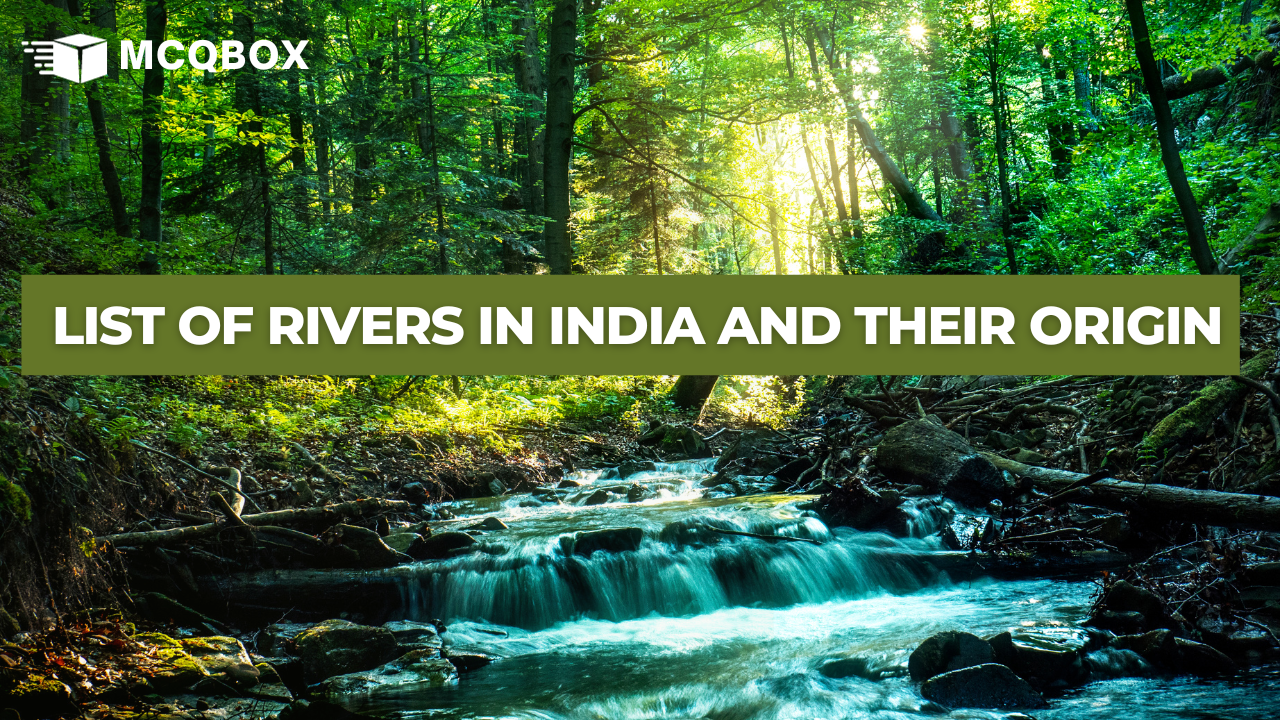List of Rivers in India and their Origin: This topic is important for students preparing for competitive exams like SSC,UPSC and State Level Exams.
India, a land steeped in diverse cultures and abundant natural beauty, boasts a network of rivers that weave through its landscape, nurturing its terrain and civilizations. The country’s rivers are more than mere water bodies; they are lifelines, spirituality, and sustenance. Let’s embark on an insightful journey into the origins and significance of some of India’s most prominent rivers.
Table of Contents

Ganges River: The Sacred Lifeline
The Ganges River, often referred to as “Ganga,” holds unparalleled significance in the spiritual and cultural ethos of India. Originating from the Gangotri Glacier in the Himalayas, this mighty river traverses a profound journey of about 2,525 kilometers before meeting the Bay of Bengal. Its source lies in the pristine surroundings of the Garhwal Himalayas, where the crystal-clear waters begin their meandering course.
The Ganges embodies a spiritual essence for millions of people, worshipped as a goddess and believed to cleanse sins and purify souls. Along its banks, the river witnesses diverse rituals, ceremonies, and festivals that highlight its sanctity. Varanasi, one of the oldest inhabited cities globally, thrives on the spiritual energy emanating from the Ganges, where ghats or steps lead pilgrims and devotees to the river’s sacred waters.
Yamuna River: The Tributary of Legends
Flowing parallel to the Ganges, the Yamuna River gracefully complements the spiritual tapestry of India. Originating from the Yamunotri Glacier in the Himalayas, this revered river traverses about 1,376 kilometers before merging with the Ganges at Allahabad (Prayagraj). The Yamuna’s journey starts amid the serene beauty of the Himalayan terrain, embellished by cascading waterfalls and pristine landscapes.
Regarded as the sister of Lord Krishna, the Yamuna holds a cherished place in Hindu mythology. Vrindavan and Mathura, two ancient cities along its banks. The river’s waters echo with legends and carry the essence of devotion, offering a serene sanctuary to pilgrims and seekers of tranquility.
Brahmaputra River: The Mighty Force of the Northeast
The Brahmaputra River, known for its majestic grandeur and vitality, originates in Tibet as the Tsangpo River. As it courses through the Himalayas, it enters India, becoming the Brahmaputra in the state of Arunachal Pradesh. This colossal river embarks on a journey of approximately 2,900 kilometers, showcasing its magnificence and shaping the landscapes it touches.
The Brahmaputra holds an integral position in the cultural fabric of Assam and the northeastern states, fostering a unique ecosystem along its banks. Its fertile plains nurture diverse flora and fauna, contributing to the region’s biodiversity. Majuli, the largest river island globally, emerges amidst the Brahmaputra’s embrace, encapsulating Assam’s rich heritage and traditions.
List of Rivers in India and their Origin
| S. No. | River | Origin |
|---|---|---|
| 1 | Ganga | Gangotri (Uttarakhand) |
| 2 | Yamuna | Yamunotri (Uttarakhand) |
| 3 | Indus | Mansarovar (Tibet) |
| 4 | Sabarmati | Udaipur, Aravalli Hills (Rajasthan) |
| 5 | Chambal | Janapav, Indore, Vindhyas (MP) |
| 6 | Ravi | Chamba (Himachal Pradesh) |
| 7 | Teesta | Tso Lhamo (Sikkim) |
| 8 | Krishna | Mahabaleshwar (Maharashtra) |
| 9 | Jhelum | Vernag (Jammu & Kashmir) |
| 10 | Cauvery | Brahmagiri Hills, Coorg (Karnataka) |
| 11 | Luni | Aravalli Hills (Rajasthan) |
| 12 | Pennar | Nandi Hills, Chickballapur (Karnataka) |
| 13 | Mahanadi | Nagri Town (Chhattisgarh) |
| 14 | Sutlej | Mt Kailash (Tibet) |
| 15 | Godavari | Nasik (Maharashtra) |
| 16 | Narmada | Maikal Hills, Amarkantak (MP) |
| 17 | Beas | Rohtang Pass (Himachal Pradesh) |
| 18 | Tapi/Tapti | Satpura Range, Betul (MP) |